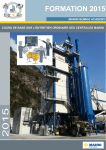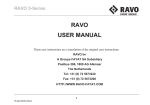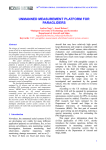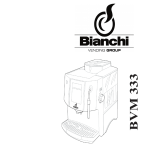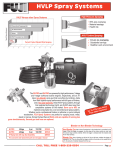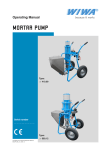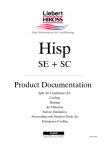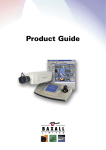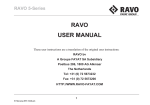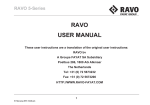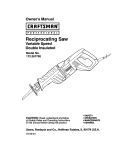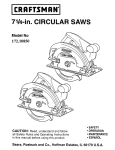Download Basic Principles Of Asphalt Compaction
Transcript
Basic Principles of Asphalt Compaction Compaction methods Compaction equipment Rolling technique Masthead © BOMAG GmbH, Fayat Group, Germany, all rights reserved Publisher: BOMAG GmbH, Hellerwald, D-56154 Boppard Project management: Dipl. Ing. H.-J. Kloubert, BOMAG GmbH, Boppard www.bomag.com Publisher's notes: The publication in its entirety is protected by copyright . All details, data, results etc. contained in this book have been created by the project management to the best of knowledge and reviewed with greatest care. However, errors as to the contents can never be completely ruled out. The project management can therefore not assume liability for any possible incorrectness as to the contents of this book. 1. Edition 02/2009 Foreword The asphalt layers of a road pavement should be able to reliably carry the traffic loads and to discharge these to the substructure or subbase, in order to prevent harmful deformation. This equally applies for load burdens resulting from weather and temperature stress. Besides the mix composition and the paving, the compaction of the mix is of utmost importance with respect to the quality and the service life of the road. On the construction site successful compaction mainly depends on the compaction technique, the knowledge and the experience of the roller driver. In this book we present an overview of compaction techniques and equipment. It contains explanations to the different rolling patterns and a number of basic rules and notes for successful compaction of rolled asphalt. The BOMAG Asphalt Compaction Handbook should serve as source of information for practicians involved in pavement construction and facilitate the use of compaction equipment in asphalt construction. Table of contents 1. Basic principles of asphalt compaction ...............................2 7. Preparing the compaction equipment .....................27 1.1 Principles.........................................................2 1.2 Influence of the mix composition .....................3 1.3 Influence of the mix temperature.....................4 8. Rolling patterns ....................................29 2. Compaction methods 2.1 2.2 2.3 2.4 Initial compaction with the finisher ..................5 Static compaction............................................6 Vibratory compaction ......................................7 Controlled compaction with ASPHALT MANAGER8 3. Compaction equipment ......................9 3.1 Hand-guided compaction equipment - Tampers - Vibratory plates - Hand-guided tandem rollers ........................9 3.2 Light tandem rollers ......................................10 3.3 Combination rollers .......................................10 3.4 Pneumatic tired rollers ..................................10 3.5 Articulated tandem rollers .............................11 3.6 Pivot steered tandem rollers .........................12 3.7 Steering systems ..........................................12 4. Equipment characteristics of tandem and combination rollers ..15 4.1 Split and non-split drums...............................15 4.2 Sprinkling system ..........................................15 4.3 Speed level switch .........................................16 4.4 Edge compressing and cutting equipment ....17 4.5 Chip spreader ................................................19 4.6 ROPS - Roll Over Protection Structure .........20 4.7 Working light ..................................................20 5. Technical data of asphalt rollers .......................................21 6. Compaction performance................23 8.1 Compacting when paving with one finisher ...29 8.2 Compacting when paving with two finishers ..30 8.3 Asphalt compaction with tandem rollers only . 30 8.4 Asphalt compaction with rubber tired and tandem rollers ........................................31 8.5 Compacting asphalt layers with crown ............ 31 8.6 Compacting in curves ....................................32 8.7 Compacting seams and joints - Transverse joints - Longitudinal joints ......................................32 8.8 Application of chips to wearing courses ........33 9. Compaction and paving faults .......35 10.Basic rules for compaction work on asphalt mixes..................................37 11.Compaction measurement and documentation systems...................39 12. APPENDIX ..............................................43 A1 Road construction classes.......................43 A2 Mix types and layer thicknesses ..............43 A3 Asphalt base course ................................44 A4 Asphalt binder course ..............................44 A5 Asphalt wearing courses .........................45 - Asphalt concrete ......................................46 - Stone mastic asphalt ...............................48 A6 Combined surface-base-course construction .............................................50 A7 Bitumen types ..........................................50 List of rules and literature..................52 1 1. Basic principles of asphalt compaction 1.1 Principles Rolled asphalts are divided into base courses, asphalt binder courses and asphalt wearing courses. Asphalt concrete, stone mastic asphalt and porous asphalts are used for asphalt wearing courses. The laid mix must be compacted to such a degree that an increase in density or a reduction of porosity in the asphalt layer is achieved. On this air voids one must make sure that the demanded degree of compaction is reached and that the limit values for the void content are complied with. This results in an enhanced stability of the layers and thus in a higher resistance against deformation. Good compaction also has a positive effect on the wear resistance of the wearing course. riding quality, skid resistance, impermeability Asphalt wearing course impermeability shear resistant Asphalt binder course Asphalt base course bearing capacity pavement subbase capping layer formation subgrade/ embankment Fig. 1 Structure and properties of an asphalt road At the same time the compaction machine should produce a level asphalt layer as desired for driving comfort, and a wearing course with closed and smooth surface structure, but with maximum grip. Objectives of compaction Compaction performance Quality characteristics Higher density Evenness Defined air voids Skid resistance High stability and wear resistance Closed surface Fig. 2 Objectives of compaction 2 1 1.2 Influence of the mix composition The composition of asphalt mixes varies widely in dependence on the expected loads caused by traffic and weather. They therefore also have quite different compaction properties. The compactibility of the asphalt mix depends on the composition of minerals as well as the quality and viscosity of the bitumen and thus also on the temperature of the mix. mix design gravel crushed aggregate low stone content high stone content small max. stone size high max. stone size properties low filler content high filler content high penetration bitumen application • low stability • sensitive to shoving • sensitive to rippling • easy to compact • lightly trafficked roads • secondary roads • local roads • cycle ways • parking areas • high stability • high internal friction • difficult to compact • heavily trafficked roads • motorways • country roads • national roads • airports low penetration bitumen Fig. 3 Composition of asphalt mix Asphalt mixes for roads with high traffic loads are designed for high deformation resistance. They are characterized by a bulky mineral skeleton structure, i.e. high stone contents, coarse grain, a high proportion of crushed grains in the sand range (crushed sand) and stiff bituminous mortar. These mixes are difficult to compact and require high compaction efforts. They are normally easy to compact, therefore do not require high compaction efforts, but, due to their lacking stability when hot after laying, may react very sensitively to the use of heavy compaction equipment or to a too early start of compaction work. This may quickly result in material displacements and the formation of bow waves. Asphalt mixes for roads with low traffic volumes normally contain a lower proportion of stones, a considerably high amount of natural sand and soft bituminous mortar. Mix instable (soft) Mix stiff (stiff) Low stability High stability Fig. 4 Rolling behaviour with different asphalt mixes 3 The temperature of the mix during compaction is of high significance for the compaction effort required. With too high mix temperatures the compaction by a roller is supported by the low viscosity of the bitumen. The bitumen acts as a lubricant and reduces the internal friction in the mineral mix. Due to the progressing stiffening of the bitumen caused by cooling, the compaction effort increases considerably under low temperatures. Compaction therefore should, as a general rule, be started as soon as possible. Compaction temperatures between 100° and 140°C have been found most favourable for the conventional bitumen types. Compaction should be completed when the temperature has dropped to between 80° and 100°C. Compaction effort 1.3. Influence of the mix temperature End of compaction Favourable compaction temperature Start of compaction Mix temperature in °C Fig. 5 Effect of the compaction temperature on the compaction effort 4 2. Compaction methods 2.1 Initial compaction with the finisher With a low pre-compaction by the finisher the use of a light roller to initially press down the mix is a very sensible decision, because too heavy roller may adversely affect the evenness of the layer and, depending on the stability of the hot mix, may cause undesired displacements and misplacements in the material. High initial compaction by the finisher has a favourable effect on the evenness of the layer and, at the same time, enables an early start of compaction, while the mix temperatures are still high. This favourably supports the compaction effect of the rollers, and final compaction can be achieved with only a few roller passes. In such a case tandem vibratory rollers should drive the first two passes without vibration. Fig. 6 Initial compaction by the finisher Fig. 7 Laying and compacting with the BOMAG BF 600 P and the BOMAG BW 174 AD-AM 5 2 2.2 Static compaction Static compaction is achieved by the deadweight of the roller. Tandem rollers and pneumatic tired rollers are used for this purpose. Compared with vibratory compaction the compaction effect is relatively low. With tandem rollers compaction is influenced by the static linear load (kg/cm) of the drum, with pneumatic tired rollers by the wheel load (t) and the tire inflation pressure (MPa). Static compaction with tandem rollers makes sense if the initial compaction by the finisher was only low, if the asphalt mix is easy to compact, in case of porous asphalts and thin layers and when ironing wearing courses. Linear load 10 - 30 kg/cm Aspahlt wearing course Asphalt base course Gravel-sand Fig. 8 Static compaction with tandem rollers With the kneading and flexing effect of their wheels pneumatic tired rollers achieve a special quality in static compaction. It leads to a homogeneous distribution of the mix and closes the pores on the surface. The main areas of application are the preprofiling and processing of easy to compact mixes Application • Surface treatment • Initial compaction of sensitive asphalt layers • Surface sealing on wearing courses Asphalt binder course Sand Contact pressure 0.20 - 0.80 MPa Compaction effect Ground contact and kneeding effect Important machine characteristics • Wheel load • Tire inflation pressure Fig. 9 Static compaction with pneumatic tired roller 6 and the finish of the surfaces of wearing and base courses or of light traffic roads. Here the pneumatic tired roller is normally combined with a smooth drum roller. 2.3 Vibratory compaction Vibratory rollers are very powerful, versatile and require considerably less passes than static rollers.The vibration reduces the internal friction in the mineral mix, so that the interaction between deadweight and dynamic load increases the density. Besides the static linear load, other factors like vibrating mass, frequency and amplitude are therefore also decisive for the compaction effect. For optimal compaction of different layer thicknesses bigger tandem vibratory rollers, in most cases with two amplitudes and two frequencies, are required. high Amplitude low Amplitude Compaction principle static pressure and dynamic energy Application • asphalt surfacing • asphalt bases • overlay compaction on granular bases Application • asphalt bases • granular bases • cement bound bases • subbases key parameters • static linear load • vibrating mass • amplitude • frequency Aspahlt wearing course Asphalt base course Gravel-sand Fig. 10 Vibratory compaction using tandem rollers with circular exciter system The rolling speed should be 3 to 6 km/h. Thickness of the asphalt layer d (cm) 2 4 6 10 14 18 Chip mastic d=2 d=4 porous asphalt d = 4 Too many passes with vibration can cause harmful loosening of material and disturbances in the structure. Number of passes with vibration with various tandem vibratory rollers 4t 7t 10t 2-4 4-6 4-8 6-8 1-2 (K) 2-4 (K) 4-6 (K) 4-8 (K, G) 6-8 (G) 6-8 (G) 1-2 (K) 2-4 (K) 2-4 (K) 4-6 (K, G) 4-6 (G) 4-8 (G) 1-2 (K) + stat. pass 4-6 (K) + stat. pass 1-2 (K) + stat. pass 4-6 (K) + stat. pass 1-2 (K) + stat. pass K = low amplitude G = high amplitude Assumption: Compaction temperature > 100°C 4t = Machine with one amplitude only 1 pass = 1 pass in forward or in reverse direction Fig. 11 Typical values for the number of vibratory passes 7 2 2.4 Controlled compaction with ASPHALT MANAGER With controlled compaction the required compaction energy is determined and automatically adjusted. In automatic mode no adjustments must be made by the driver. Rollers with ASPHALT MANAGER work with a directed exciter system; it is automatically regulated. During compaction the effective amplitude is optimally and continuously adapted to the actual conditions. Grain damages and disturbances in the structure of the asphalt are effectively prevented. Besides working in automatic mode, the roller driver is also able to pre-select a certain direction of vibration (manual mode). low dynamic energy due to horizontally directed vibrations Gravel-sand There are six different directions available, ranging from vertical to horizontal (similar to oscillation). Due to their excellent adaptability, rollers with ASPHALT MANAGER are highly suitable for the complete spectrum of asphalt applications. Manual mode with horizontal vibrations is recommended for the compaction of layers on bridges, on/in multi-storey car parks or in the vicinity of structures which may be sensitive to vibrations. Compaction effect Deadweight and dynamic energy, the compaction effect is automatically adapted to compactibility of material, layer thickness and subbase. high dynamic energy due to vertically directed vibrations Application: all soil types, granular bases and subbases Fig. 12 Vibratory compaction ASPHALT MANAGER with directed exciter system • Universal use • Higher compaction performance without the risk of grain destruction • Uniform compaction by continuous adaptation of the compaction energy • Better evenness and more uniform surface structure on asphalt layers • Unproblematic behaviour of the roller when compacting along edges and joints • Optimally suited for layers on bridges and in the vicinity of constructions that may be sensitive to vibrations (similar to oscillation) • Equipped with compaction and temperature measuring facilities Fig. 13 Benefits of rollers with Asphalt Manager 8 3. Compaction equipment 3.1 Hand-guided compaction equipment Tamper Tampers belong to the smallest compaction machines used on construction sites. They are used under confined spatial conditions, where larger compaction machines cannot be used. They are available in the weight class from 60 - 80 kg. Tampers are powered by modern 4-stroke gasoline engines or, more rarely, by diesel engines. The engine driven eccentric (crank drive) causes the fast vertical movement of the tamper foot. Fig. 14 Tampers Vibratory plates Forward running and reversible vibratory plates are used for the compaction of small or confined asphalt surfaces. They are available in the weight range from 50 - 150 kg with working widths ranging from 45 to 60 cm. Vibratory plates are powered by gasoline or diesel engines. The exciter system (directed vibrator) is driven via V-belt and centrifugal clutch. The movement direction of reversible plates is achieved by adjusting the directed vibrator accordingly. Fig. 15 Vibratory plate Hand-guided tandem rollers Hand-guided tandem rollers are available in the weight range from 600 - 1000 kg with working widths ranging from 60 cm - 75 cm. Both drums are either mechanically driven by a 2-stage mechanical gearbox, or by a hydrostatic drive. These rollers work with double vibration. Fig. 16 Hand-guided rollers 9 3 3.2 Light tandem rollers Light, articulated tandem rollers are ride-on rollers in the weight class from 1.3 to 4.2 t and working widths ranging from 80 cm to 138 cm. They are designed with hydrostatic travel and vibration systems for both drums. Fig. 17 light, articulated tandem rollers 3.3 Combination rollers Combination rollers are designed with a vibrating drum and a wheel set.They are particularly suitable for asphalt compaction on inclinations, for repairs and patchwork in the construction of footpaths, cycle paths and car parks. Combination rollers are available in the class ranging from 1.5 to 2.5 t and also from 7 to 10 t. Fig. 18 Combination roller 3.4 Pneumatic tired rollers Pneumatic tired rollers are designed with a steering/oscillating axle at the front and a rigid drive axle at the rear. With an additional ballast of 10 t the deadweight of these rollers can be increased to 24 or 27 t respectively. The compaction effect is achieved with the deadweight of the machine and the kneading and flexing effect of the wheels. The tire inflation pressure affects the efficiency of compaction (e.g. the number of passes). Fig. 19 Pneumatic tired roller 10 Both axles are equipped with 4 compactor wheels each; the wheels overlap (track offset) by approx. 40 mm). 3 Fig. 20 Wheel position of the pneumatic tired roller 3.5 Articulated tandem rollers Heavy tandem rollers in the weight range from 7 to 14 t with working widths of 1.50 m, 1.68 m, 2.00 m and 2.13 m are used for medium to large scale construction projects. Vibration: • only front • or only rear • or both drums Drums: • split or non-split Fig. 21 Articulated tandem rollers On rollers with central oscillating articulated joint both drums remain in track, even when cornering (left/right). The rollers have a standard crabwalk facility of 170 mm to either side. This facilitates among others the compaction along edges and the moving away from lateral limitations. Fig. 22 Steering concept (articulated steered) 11 3.6 Pivot steered tandem rollers Pivot steered tandem rollers are available in the 7 and 10 t weight range with working widths of 1.50 m and 1.68 m. The travel and vibration drives are hydrostatic Vibration: front and/or rear Drums: front and rear: split or non-split Fig. 23 Pivot steered tandem rollers The BOMAG pivot steering is a particularly convenient electric steering system. The driver can choose from the following settings: • • • • • Fig. 24 Types of steering with pivot steering Diagonal (left/right) Only front Only rear Synchronous steering (both drums) Automatically front or rear depending on travel direction 3.7 Steering systems Fig. 25 Pivot steering On pivot steered rollers both drums can either be steered together (synchronous steering) or individually at front or rear. Pivot steered rollers are additionally designed with a large adjustable crabwalk (up to 120 mm). 12 Pivot steered rollers are optimally suited for both small scale constructions (e.g. crossings, roundabouts, sharp bents) as well as large area projects (e.g. A-roads and motorways). max. to 120 cm 3 Fig. 26 Crabwalk On pivot steered rollers full advantage can be made of the large "crabwalk" (up to 120 mm): • The weight of the roller is distributed over a larger area; the roller does not sink in so deep. • Unproblematic initial compaction of sensitive materials with high asphalt temperature • • Final "ironing" of large areas. The roller has a larger distance to the still instable edge of the asphalt layer. Fig. 27 Articulated steering Tandem rollers with articulated steering have a central articulated oscillating joint between the drums. This ensures that both drums run in track, even when cornering. When using the crabwalk the rear drum is offset either to the left or the right. Due to their design the tracks of tandem rollers can be offset by < 17 cm. Practical benefits of the crabwalk facility: • • • Unproblematic steering away from curb stones Rational working with the edge compressing cone Avoids sharp-edged track marks from the drum edges in the asphalt surface 13 14 4. Equipment characteristics of tandem and combination rollers 4.1 Split and non-split drums Less shearing forces in tight curves non split split Tandem rollers with an operating weight of 7 t and higher are available with split or non-split drums. The benefit of the split drum are the reduced shearing forces when compacting highly sensitive asphalt layers in curves (urban applications). The risk of the asphalt cracking in the area of the drum edges is considerably reduced. 4 BW 151 BW 170 non split drum BW 154 BW 174 split drum Fig. 28 Split and non-split drums 4.2 Sprinkling system Large tandem rollers are normally designed with two water pumps (1 spare pump). Combination rollers are equipped with an additional pump to spray the rubber tires with emulsion. All rollers are equipped with interval switches to save water. With the switches the water quantity can be exactly metered for the application. The following applies in general: The drum surface should be moist but not wet. This requires an excellent view to the drum surface. Fig. 29 The sprinkling system Switch for sprinkling system Type of mix Explanation: Asphalt ° C ( 100 – 140 ) Asphalt °C ( > 150) Permanent sprinkling Stage 3–5 Asphalt concrete Stage Stage 5–8 12 Chip mastic asphalt - Fig. 30 Reference values to preselect the sprinkler interval Note: Stage 12 of the sprinkler switch is used to check the function of the sprinkling system at standstill before work is started. During work it is only used to wet the drum surface instantaneously and quickly. 15 4.3 Speed level On tandem rollers the rolling and transport speeds of the machine are controlled with the travel lever, on pneumatic tired rollers with the throttle pedal Depending on the roller type, the desired final speed can be pre-set with a speed range switch, which particularly serves this purpose. On pivot steered rollers the maximum travel speed can be pre-selected with a 24-stage switch. This speed is then reached when the travel lever is fully operated (in forward / reverse), which guarantees uniform compaction. Fig. 31 Speed level selection BW 174 AD On heavy articulated roller (BW 161 AD and higher) the speed can generally be adjusted in two steps from working speed to transport speed. This enables perfect adaptation of the travel hydraulics to the prevailing construction site conditions. Fig. 32 Speed level selection BW 161 AD-4 5 4 7 6 4 8 5 9 6 2 3 2 3 An analog speedometer is also available (optionally). On rollers with ASPHALT MANAGER the speed a digital display (BOP) shows the speed as standard. 7 1 1 11 12 8 0 mph km/h Fig. 33 Option: Speedometer 16 10 13 4.4 Edge compressing and cutting equipment All small tandem rollers with edge cutting unit (weight range up to 4 t) are equipped with three tools ex factory: a) Compression roller with 45°-angle b) Cutting wheel c) Tapered roller For large tandem rollers compression rollers (45° or 60° -angle) and a cutting wheel are optionally available. The free edges of asphalt layers must be compressed with suitable tools, like e.g. edge compressing rollers. Fig. 34 Edge compressing unit The special shape of the tapered roller enables the roller driver to compact right against lateral limitations (e.g. walls of buildings). Since this usually only possible with light tandem rollers, the conical roll is only intended for tandem rollers with a weight of < 4 t. Fig. 35 Conical roll The cutting wheel enables clean cutting of wearing courses along edges and middle joint, as well as along curb stones / edge of gutters. Fig. 36 Cutting wheel 17 4 Working with compressing roller or cutting wheel requires some experience. The attached tools can generally be conveniently operated from the operator's stand. For this purpose the machine is equipped with a hydraulic pressing system. Depending on the application it may be necessary to readjust the final stop for the swivel arm (roller position below drum). Tandem rollers can also be equipped with two compressing rollers (front right and rear left). Inclination1:1 45° Inclination 2:1 approx. 60° Fig. 37 Compressing rollers and cutting wheel Fig. 38 Compressing roller with inclination 1:1 (45°) Fig. 39 The compressing roller produces a slanted and smooth layer edge 18 4.5 Chip spreader For accurate distribution of chips over the asphalt surface BOMAG offers attachment spreaders with various capacities for rollers in the weight class from 2.5 to 4 t as well as from 7 - 10 t. Precision spreaders (BS 150 and BS 160) with vibrating spreading screed are available for the large tandem rollers - hydraulically driven roller-type spreaders (BS 100 and BS 120) can be attached to the light tandem rollers. The objective of this measure is the application of grit to the asphalt surface to enhance the initial grip. Spreading widths from 1.00 m to 1.80 m are possible. The spreading quantity can be adjusted by varying the hopper inclination angle at constant working speed.The hopper itself can be easily detached from the roller by simply disconnecting a hydraulic quick release coupling. The hopper can be conveniently filled on site by means of a wheel loader. Fig. 40 BW 154 with BS 150 - Precision chip spreader The attachment spreaders BS 100 or BS 120 are hydraulically driven roller-type spreaders for installation on small tandem rollers of the 2.5 - 4t class. Fig. 41 BW 120 with attachment spreader BS 100 and foldable roll over protection structure 19 4 4.6 ROPS - Roll Over Protection Structure All small tandem rollers can be optionally equipped with a roll over protection structure (rigid or foldable). All large rollers are either equipped with a ROPS* - cab (standard in EU countries) or with ROPS-FOPS** (with protection against falling down objects). *ROPS = Roll Over Protection Structure **FOPS = Falling Object Protection Structure Fig. 42 Articulated roller with ROPS/FOPS 4.7 Working light BOMAG rollers can be equipped with a 230 V power connection for large area illumination of over-night construction sites. A balloon with very bright halogen lamps (2 kW) enables uniform illumination of the construction site around the roller (approx. 500 m2). Fig. 43 Tandem roller with 230 V electrical connection 20 5. Technical data of asphalt rollers BOMAG offers optimally adapted tandem and combination rollers in the weight ranges from 1.5-4 t and from 7 - 14 t to suit the vast variety of applications in asphalt compaction. The following tables give the user a complete overview of the most important roller data in a particular weight class. Small tandem rollers Weight class Linear load Working width Engine power Amplitude Frequency Centrifugal force t kg/cm mm kW mm Hz kN 1,5 - 2,5 8-13 800-1200 12-25 0,4 - 0,5 50-70 20-45 3,2 - 4,2 13-15 1300-1380 25-35 0,4-0,5 45-60 25-50 5 Fig. 44 Characteristics of small tandem rollers Large tandem rollers* AM AM Weight class t 7-10 + 10-14 + Linear load kg/cm 25-30 + 27-32 + Working width mm 1500-1680 + 2000-2135 + Engine power kW 55-75 + 75-100 + Amplitude mm 0,3-0,7** 0 - 1,0** 0,35-0,85** 0 - 0,95** Frequency Hz 40-60 45 40-60 40-50 Centrifugal force kN 70-90 160-170 85-130 150-250 * Operating weight with cabin AM = ASPHALT MANAGER **effective amplitude Fig. 45 Characteristics of large tandem rollers Due to its highly sensitive kneading and flexing effect of the wheels the roller is particularly significant for purely static compaction. Pneumatic tires rollers Weight class Wheel load Ballast Tire size Number of tires Working width Speed Engine power t kg t mm km/h kW 8-27 1000-3000 5-12 11.00-20 18 PR 4 front; 4 rear 2050 20 75-100 Fig. 46 Characteristics of rubber tired rollers 21 22 6. Compaction performance The area or volumetric output of the laying and compaction equipment is interdependent. These two outputs must therefore be exactly planned and calculated in mutual dependence. The area output depends on the laying width, the working speed and the utilization factor of the finisher. The quantitative output results from the amount of mix and the area output of the finisher. The area output or volumetric output of the compaction machines is influenced by the available rolling time as well as the number, operating mode, rolling speed and rolling width of the machines. The combination of compaction equipment to be used must follow the objectives of a number of influential factors and various quality criteria, such as e.g. adequate compaction, even surface with closed pores, internal bonding of layers, compaction of joints. 6 Fig. 47 Laying and compacting an asphalt layer using three finishers and five vibratory rollers (10t). Laying width > 10m; daily output > 3.000t. 23 The following formula is used to calculate the practical rolled area output F and the quantitative output M of a roller: F= f • beff • v • 1000 n (m2/h) Meaning: F = Area output by rolling (m2/h) f = Reduction factor (0.75) beff = Effective rolling width (m) (90% of drum width because of overlapping) v = Mean rolling speed (km/h) n = Number of passes M= f • beff • v • h • δA • 1000 n (t/h) Meaning: M = Volumetric output (t/h) f = Reduction factor (0.75) beff = Effective rolling width (m) (90% of drum width because of overlapping) v = Mean rolling speed (km/h) h = Layer thickness of material to be compacted (m) δA = Density of mix to be compacted (t/m3) (δA ∼ 2,4 - 2,5 t / m3) n = Number of passes The following average speeds are recommended: 4 to 6 km/h for initial compression 3 to 5 km/h for main compaction 3 to 5 km/h for main compaction 6 to 8 km/h for subsequent rolling (ironing) 4 to 8 km/h for main compaction 10 to 12 km/h for subsequent rolling (statically with tandem rollers) (statically with tandem rollers) (Vibration) (statically with tandem rollers) (Pneumatic tired roller) (Pneumatic tired roller) Fig. 48 Recommended rolling speeds The number of necessary rolling passes can only be estimated in advance on the basis of experience or must be determined by compaction tests. In each individual case the number of passes depends on the compaction resistance and the temperature of the mix, 24 the thickness of the layer, the rolling speed, the roller type and the operating mode of the machine. The following tables contain empirical values for the area output (m2/h) and the quantitative output (t/h) of compaction equipment from BOMAG. Machine type Operating weight t 1,5-2,5 3,0-4,5 7-9 10-14 1,5-2,5* 3,0-4,5* 7-10* 2-4 cm 250-450 400-800 600-1500 1000-2200 250-450 400-800 600-1500 Area output (m2/h) with layer thickness 6-8 cm 200-350 250-600 500-900 800-1200 200-300 250-500 500-800 Fig. 49 Practical area output of compaction equipment in asphalt construction Machine type Operating weight t 1,5-2,5 3,0-4,5 7-9 10-14 1,5-2,5* 3,0-4,5* 7-10* 2-4 cm 10-40 20-60 40-100 70-120 10-35 20-55 35-100 10-14 cm 150-300 250-450 400-700 600-900 150-250 250-400 400-650 *Combination roller Volumetric output (t/h) with layer thickness 6-8 cm 10-14 cm 25-60 40-100 40-90 70-160 70-160 120-220 100-200 180-280 20-55 35-90 35-80 65-140 60-170 90-200 *Combination roller Fig. 50 Practical volumetric output of compaction equipment in asphalt construction Fig. 51 BW 203 AD on a 16cm asphalt bearing course with a compaction performance of 250 t/h 25 6 26 7. Preparing the compaction equipment In order to be able to perform high quality compaction work, the "tools" required for this work must be optimally maintained or checked for functionality. This includes thorough inspection of the machine with respect to engine, hydraulic system and water sprinkling system, before work is started. Possible faults, which could later cause major problems during compaction work, can thereby be detected at an early stage. Fig. 52 Filling the water tanks, checking the water nozzles Activities before starting work: • Check the nozzles, clean or replace if necessary. • Fill the water tanks • In case of frost drain the complete water sprinkling system; unscrew all nozzles. • Check the water filter (in case of frost unscrew the filter to drain the pump). 7 Fig. 53 Fuel level, engine oil check • Check the engine oil level • Check the fuel level • General function test (Brake, light, warning horn, hazard light) 27 Fig. 54 The scrapers must be in contact Scrapers should always touch the drum uniformly. • Foldable scrapers are maintenance free Function and characteristics of scrapers: • Fixed scrapers must be checked at regular intervals and readjusted when required. • Even distribution of sprinkling water • Removal of large particles t 12-15 18-21 24-27 bar 3-5 6-7 6-8 Fig. 55 Recommended tire pressures With pneumatic tired rollers the efficiency of compaction mainly depends on the tire pressure. In dependence on the corresponding wheel load the correct pressure must be adjusted so that the wheels have an even contact area. The working speeds range from 4 to 8 km/h. Fig. 56 Pressure distribution and optimal tire contact area 28 8. Rolling pattern 8.1 Compacting when paving with one finisher Depending on the paving width of the finisher one or several rollers will be used side by side. The respective rolled tracks should overlap by at least 15 cm, to make sure that no uncompacted strips are left out. The same number of passes should be rolled on each track to ensure even compaction over the entire paving width. 2nd rolled field 1nd rolled field 1 15cm 0 20-30m / 0 01 / / 20-30m #60m 8 Fig. 57 Sequence of the compaction process (several fields) The roller always follows the same rolled track back to the already cooled down, load-bearing area, where it is then reversed. If a curbstone, compaction will start right at the outer edge. Depending on mix, initial compaction and layer thickness it is recommended to finish the rolled track behind the finisher (field 1) with a slight radius to improve the transverse evenness of the surface. Fig. 58 BW 154 AP compacting a wearing course with a curbstone 29 8.2 Compacting when paving with two finishers 2 15-30cm 1 0 / 15cm 1 0 2 / 15-30cm Fig. 59 Rolling concept with 2 pavers When paving with staggered finishers (hot on hot), the joint should be compacted at the earliest possible time. For this purpose the rollers compact, e.g. in the right hand field, from the outer edges towards the middle. In the left hand field the joint is rolled immediately. Here the rolled field overlaps the right field by 15 cm. This forces an intensive and dense connection between both tracks. 8.3 Asphalt compaction with tandem rollers only 6m #50-60m Fig. 60 Rolling concept with tandem roller All types of mixes (base, binder and wearing courses) can generally be compacted with tandem vibratory rollers. The use of a pneumatic tired roller is not mandatory. Utilizing a high temperature level (approx. 140 - 160° C) has highest priority. The number of rolling passes with vibration depends on the layer thickness, 30 the linear load and the weather conditions. Depending on the stability and initial compaction of the mix it is most sensible to start with static initial compaction and subsequently continue the main compaction process with vibration. 8.4 Asphalt compaction with rubber tired and tandem rollers 6m #50-60m Fig. 61 Rolling concept with pneumatic tired and tandem rollers Critical mixes, which are sensitive to scuffing, as may be used for binder and base courses or combined surface - base - course constructions, are initially compacted with pneumatic tired rollers. Here the wheels produce a highly beneficial kneading and flexing effect, without the danger of scuffing or tearing. Tandem rollers (7 - 10 t) are normally used for final compaction. Fig. 62 Initial compaction, pneumatic tired roller BW 24 RH 8.5 Compacting asphalt layers with crown 1 2 0 / 8 1 2 0 / Fig. 63 Compacting a crown profile On traffic areas with crown profile the longitudinal joint should be compacted in such a way, that a closed joint of identical height is produced. This requires a certain level of experience and diligence from the roller driver. Fig. 64 Main compaction, BW 174 AD 31 8.6 Compacting curves both drums split both drums split Fig. 65 Cornering with articulated rollers Fig. 66 Cornering with pivot steering Articulated rollers should be used with crabwalk when compacting along the edge of the carriageway. This enables the roller driver to direct his attention to one drum when compacting the edge. 8.7 Compacting seams and joints - Longitudinal joints 5-20cm - Transverse joints 5-20cm Transverse joint = hot asphalt = cold asphalt Longitudinal joint = hot asphalt = cold asphalt Fig. 67 Transverse joint without traffic Fig. 68 Longitudinal joint without traffic In order to compact transverse joints across the direction of paving the roller drives with only 5-20 cm of the drum on the hot, uncompacted layer and then moves bit by bit onto the hot layer. Since the manoeuvring space is in most case quite limited, a small and manoeuvrable compaction machine should be used for this purpose. If the available space is not big enough for manoeuvring, the transverse joint can also be rolled or even paved diagonally to the paving direction. 32 When compacting a longitudinal joint (without oncoming traffic) approx. 20 cm of the hot mix is compacted. The major part of the drum rolls over the cold, stable material. This produces a closed joint with identical height without misplacements. 15-cm When rolling a longitudinal joint (with oncoming traffic) the rolling pattern 1-3 should be used. This produces a solid, stable basis, from which the roller can finally roll the longitudinal joint. Longitudinal joint = hot asphalt = cold asphalt Fig. 69 Longitudinal joint with traffic 8 Fig. 70 Compacting a longitudinal joint 8.8 Application of chips to wearing courses The grip of asphalt wearing courses is a very significant factor within the framework of general traffic safety. With the introduction of the ZTV Asphalt StB01 the requirements concerning grip from the date of acceptance right to the end of the warranty period were determined in terms of figures and, since 01.01. 2002, are a fixed part of construction contracts in Germany. These requirements apply for roads or construction class SV and l to VI. The right spreading technique is all what matters: Skid resistance is a characteristic of road surfaces, which is essentially determined by the concept of the mix and the paving technique. The initial grip is fundamentally influenced by paving - i.e. by correct rolling and chip distribution. Chip material: Crushed sand or multiple crushed chipping (raw or binder coated) is normally used. The material should only be used dry and free of dust. Chip quantity: The quantity is, among others, determined by the particle size of the wearing course and is generally in the range of 0.5 to 1.0 kg/m2, with particle size 1 / 3 mm (for wearing courses up to 0 / 8 mm) 1.0 to 2.0 kg/ m2, with particle size 2 / 5 mm (for wearing courses > 0 / 8 mm) Timing: The chips should be applied to the surface of the still hot wearing course at a time when it can still be pressed in by rolling. This should take place at the earliest after the 2nd rolling pass. 33 Fig. 71 BW 174 AP with precision chip spreader BS 180 Fig. 73 Spreading quantity: Evenly, exact Gritting asphalt surfaces requires a uniform and precise spreading technique. Since years BOMAG for this purpose delivers the approved and patented precision chip spreader BS 180 for installation on 7 to 10 t tandem rollers. The vibratory screed (under the hopper) distributes the chip evenly across the full rolling width. An excellent and reproducible spreading quality is reached with a constant rolling speed of approx. 4-6 km/h. The material spread over a test section is weighed for the initial determination of the spreading quantity per m². For this purpose the material spread over a reference area (1m²) is swept up and weighed. The spreading quantity depends on the inclination of the hopper (see angle scale on hopper) and a constant speed of the roller (approx. 4-6 km/h). With constant working speed the spreading quantity can be changed by tilting the hopper accordingly. Additional advantage: With an even and accurate distribution of the chip a significantly lower chip quantity (600 - 800 g/m²) is very often required - in contrast to the reference values stated above. The hopper can be optionally moved sideways. Fig. 72 Chip hopper laterally displaceable 34 Fig. 74 Spreading quantity regulation 9. Compaction and paving faults Frequently occurring problems in practice when rolling asphalt layers can be traced back to various causes. Fig. 76 Mix sticking to the drums Mix sticking to the drum Fig. 75 Scuffing of mix in front of the drum Scuffing of asphalt mix in front of the roller The roller pushes a bow wave in front Possible causes are: • Too heavy roller (high linear load) with to small drum diameter • In stable mix is compacted too early at a too high temperature. Possible causes are: • The mix is compacted at a too high temperature • The drums are insufficiently sprayed with water. Recommendation: • Before starting compaction work set to permanent sprinkling (stage 12) to wet the drums all around. Recommendation: • Use a lighter roller • Initial compaction with pneumatic tired roller or combination roller • Later start of compaction with reduced mix temperature 9 Fig. 77 Cambering along the side of the drum Cambering along the side of the drum The following causes are possible: • Insufficient initial compaction • Mix too hot. • Wrong composition of mix. 35 Fig. 78 Transverse cracks behind drum Fig. 79 Longitudinal cracks Transverse cracks • Poor stability of the mix due to its composition (especially the high contents of natural sands) • Too high temperature of asphalt mix. • Poor bonding of layers. • Too high binder content in mix. • Demixing phenomena as a result of poor mix distribution. Transverse cracks normally do not reach very deep. Possible causes are: • Low initial compaction by finisher • Too early use of too heavy rollers • After paving the time until starting compaction is too long (the surface has cooled down, the core is still too hot, the roller penetrates the skin). • The machine displaces the paved material on the subbase (the subbase is dirty or insufficiently sprayed). • The asphalt surface is "quenched" (wind, too much sprinkling water). • Compaction of too thick layers on inclinations (the thrust forces of the roller cannot + be absorbed). • Use of so-called short mixes (high amount of and poorly graded natural sand, low amount of bitumen). • Layer is over-compacted. • Demixing phenomena as a result of poor mix distribution. Longitudinal cracks Longitudinal cracks reach through the entire layer The most frequent causes are: • Faults in the subbase • Shearing of the mix under a heavy roller (paving thick layers, a heavy roller has to wait a long time, the surface cools down and forms a skin with a hot core zone, the mix is sheared off during rolling. • Insufficient initial compaction. • Layer is over-compacted. 36 Fig. 80 Transverse and longitudinal cracks cause by the use of a too heavy roller 10. Basic rules for compaction work Very high quality demands apply for the compaction of asphalt. They are intended to achieve a load bearing and wear resistant pavement, able to cope with the expected loads. Minimum values concerning evenness and durable grip of the surface must also be fulfilled. The roller operator himself is also able to influence these quality characteristics by following some general rules. 1. Start compaction work as early as possible. This also applies when using heavy rollers directly behind the finisher. However, the flatness produced by the finisher must not be disturbed. 2. Start edge compression as early as possible, so that the mix is still deformable. 3. Drum and tires must be sprayed with a sufficient amount of water to prevent mix from sticking to the drum. Drum and tires should be damp but not wet. The sprinkling water is evaporated by the hot mix, which looses heat, and thereby reduces the available compaction time. Sprinkling with interval control reduces the required amount of water, similar to the addition of dispersant agent to the sprinkling water. 4. Start smoothly and do not reverse jerkily. 5. Do not vibrate at standstill to avoid the formation of ruts. 6. Only switch on vibration when driving, when reversing switch off vibration before the actual reversing point is reached (or use the automatic vibration shut-down feature). 7. On cross-sloped carriageways always start to compact from the lower edge towards the higher edge. This way the mix compacted by the roller acts as an abutment, which supports the roller. 8. If possible displace and steer the roller only on compacted material, to avoid misplacements of material. 9. Never stop the roller on still hot mix, since this could deform the layer. 10. Always park the machine across the paving direction to be able to iron out any possible ruts. Fig. 81 Basic rules of asphalt compaction 10 37 38 11. Compaction measurement and documentation systems Rollers with ASPHALT MANAGER automatically regulate the required compaction energy by matching the effective amplitude to the prevailing conditions. At the same time the stiffness modulus EViB (MN// m²) is continuously determined and the asphalt surface temperature is measured by an infrared sensor. The related information is displayed in the BOMAG Operation Panel (BOP). This enables easy tracking of the compaction progress. Fig. 82 Asphalt Manager with compaction measuring system With an assumed uniform stiffness of the layer subbase and a compaction temperature in the range of >100 °C, good correlations between density and EVIB can be determined on site by comparative measurements. Experience shows that the roller integrated measuring technique facilitates the compaction quality of asphalt layers. Fig. 83 Compaction measurement for comparison with EVIB Correlation EVIB - degree of compaction, A 65, SMA 0/8 S, BW 174 340 EVIB [MN/m2] 320 300 280 260 y = 6,6224x - 334,18 R2 = 0,5724 240 11 220 90 92 94 96 98 100 Degree of compaction [%] Fig. 84 Example of a correlation between degree of compaction and EVIB 39 If the setpoint is exceeded, the EVIB display will change from yellow to green. EVIBdisplay Amplitude display only used in the menu for functions Speedometer Specification of setpoint Only used if machine is equipped with printer and a measufrement is to be documented. F5 - Start measurement F6 - Stop measurement F7 - Measurement printout F8 - Delete measurement (when changing track) yellow slight jumping red strong jumping Menu with special functions for Language and service settings Escape Display of vibration direction or amplitude stage In manual mode Force level display F12 Operating mode Automatic only used in the menu for optional functions F11 Manual mode F13, F14 or P3 Force level switch for automatic mode Temperature display for asphalt surface F9 F10 or P1 Amplitude selection in manual mode Fig. 85 BOMAG Operation Panel (BOP) Force level switch In automatic mode both the maximum compaction power and the depth effect can be limited. 3 stages are available for this purpose. This is limitation is very beneficial if the subbase under the layer to be compacted is not stable. Temperature display The temperature is continuously recorded as asphalt surface temperature. Depending on layer thickness, ambient temperature and wind force, the mix temperature in the core of the layer may be up to 40 °C higher. Compaction should be completed when a surface temperature of 80 °C is reached. 40 The application of a continuous compaction control on asphalt (CCCA) requires the use of the following modules: BCM 05 display with BCM 05 mobile software BCM05 office software BCM 05 Positioning software GPS-system USB memory sticks are used to transfer data from BCM 05 to the construction site office. Here the data are evaluated and managed with the BCM 05 Office program module. Fig. 86 Asphalt Manager with BCM 05 Rollers with ASPHALT MANAGER can be equipped with the documentation system BCM 05 and a GPS-system to record all data. Fig. 88 BW 174 AM with BCM 05 and GPS This system enables complete and watertight documentation of all stiffness values EVIB (MN/m²), asphalt surface temperatures during compaction, roller application values (frequency, amplitude, speed), position of the compacting machine and number of passes for large-scale construction projects. 11 Fig. 87 Continuous compaction control on asphalt CCCA Fig. 89 CCCA documentation of measuring values and passes 41 42 12. Appendix A1 Road construction classes The total thickness of the road pavement and the gradation of the individual layers with respect to type and thickness are divided into construction classes, according to the traffic load. In Germany the most suitable road design is taken acc. to certain criteria Construction class SV Equival. 10-t axle passes in Mio > 32 Thickn. of frost prot. pavement 55 65 75 85 Asphalt bearing course on frost blanket layer from tables with standardized traffic area pavements. These tables can be found in the "Richtlinien für die Standardisierung des Oberbaues von Verkehrsflächen" (currently RStO-01*) (Guidelines for the standardization of traffic area pavements). I > 10 - 32 55 65 75 85 II > 3 - 10 55 65 75 85 III IV > 0,8 - 3 > 0,3 - 0,8 45 55 65 75 45 55 65 75 V VI < 0,1 > 0,1 - 0,3 35 45 55 65 35 45 55 65 25 35 45 55 29 39 49 59 - 21 31 41 51 Wearing course Binder course Asphalt base course Frost blanket layer Thickness of frost blanket layer - 31 41 51 33 43 53 27 37 47 57 25 35 45 55 Fig. 90 Examples for road construction with asphalt pavement acc. to RStO A2 Mix types and layer thicknesses When designing asphalt layers one must consider the ratio of layer thickness and biggest grain. By experience the layer thickness should here by 3-4 as big as the biggest grain used in the asphalt layer. Otherwise negative properties with respect to compactibility and Layer Types of mixes Asphalt wearing courses Asphalt concrete 0/5 Asphalt concrete 0/8 Asphalt concrete 0/11 Asphalt concrete 0/11S Asphalt concrete 0/16S Stone mastic asphalt 0/5 Stone mastic asphalt 0/8 Stone mastic asphalt 0/8S Stone mastic asphalt 0/11S Mastic asphalt 0/5 Mastic asphalt 0/5 Mastic asphalt 0/11 Mastic asphalt 0/11S Asphalt binder 0/11 Asphalt binder 0/16 Asphalt binder 0/16S Asphalt binder 0/22S Mix types 0/22 Mix types 0/32 Asphalt binder courses Asphalt base layers deformation resistance can be expected. In general the layer thickness follows the regulations ZTV Asphalt StB* and RstO*. *German regulations Layer thickn. acc. to ZTV Asphalt-StB* or ZTVT-StB [cm] Recommended layer thickness for specifications [cm] 2,0 to 3,0 3,0 to 4,0 3,5 to 4,5 4,0 to 5.0 5,0 to 6,0 2,0 to 3,0 2,0 to 4,0 3,0 to 4,0 3,5 to 4,0 2,0 to 3,0 2.5 to 3,5 3,5 to 4,0 3,5 to 4,0 only for profile compens. 4,0 to 8,5 5,0 to 8,5 7,0 to 10,0 >8,0 >8,0 2,0 3,0 4,0 4,0 5,0 2,0 3,0 3,5 4,0 2,0 2,5 3,5 3,5 5,0 6,0 8,0 >8,0 >8,0 12 Fig. 91 Asphalt mix types and the corresponding layer thicknesses 43 A3 Asphalt base course For new road constructions the asphalt base course (single or multi layer) is laid on the unbonded frost blanket layer (gravel or crushed rock layer) of the pavement. It mostly consists of a mixture of coarse particle materials (0/32 mm or 0/22 mm) with additives and bitumen. Type of mix 1 Base courses have the function of distributing loads; they should therefore be particularly stable and must be paved true to profile. Moreover, they should protect the substructure against moisture (rain). Particle size Particle size > 2 mm Particle size < 0.09 mm Over-size max. Minimum binder content* Marshall stability at 60°C min. ** Marshall flow** Air void content mm Weight-% Weight-% Weight-% Weight-% kN mm Vol.-% 2 3 4 6 7 8 9 10 AO 0/2 to 0/32 0 to 80 2 to 20 20 3,3 2,0 1,5 to 4,0 4,0 to 20,0 A 0/2 to 0/32 0 to 35 4 to 20 10 4,3 3,0 1,5 to 4,0 4,0 to 14,0 B 0/22; 0/32 over 35 to 60 3 to 12 10 3,9 4,0 1,5 to 4,0 4,0 to 12,0 C 0/22; 0/32 over 60 to 80 3 to 10 10 3,6 5,0 1,5 to 4,0 4,0 to 10,0 CS 0/22; 0/32 over 60 to 80 3 to 10 10 3,6 8,0 1,5 to 5.0 5.0 to 10. Explanations 1) Mix types AO only for full depth asphalt pavements 2) Mix type A only for lower layer of base course 3) Mix type CS for construction class SV and subject to special loads traffic areas: minimum 60% crushed grain > 2 mm, ratio of crushed sand to natural sand min. 1:1 4) Mix types B, C, CS possible for all other pavements or construction classes (B limited) 5) *for the use of paving bitumen 6) **Determination on marshall samples Fig. 92 Composition and properties of asphalt base courses A4 Asphalt binder course On roads with higher traffic loads (construction class III and higher) the binder course is applied to the tackcoated base course as a single layer. As already indicated by its name, this layer bonds the wearing course to the base course; it thereby has the function of a compensating layer to optimize the evenness. Apart from this, the binder course also absorbs a significant part of the shearing strain caused by traffic. The particle size of the mix is in the region of 0/11 to 0 / 22 mm). 44 Typical applications are highly stressed traffic areas. Mix types used for asphalt binder courses must have very high and durable deformation resistance properties. Multiple crushed stones with durable edges are used for this purpose.The mix has a high proportion of coarse particles and crushed sand and therefore shows a tendency of demixing during haulage to the construction site and paving with a finisher. Asphalt binders generally require a high compaction level. Minerals Particle size fraction mm Grain fraction < 0,09 mm wgt-% Grain fraction > 2 mm wgt-% Grain fraction > 8 mm wgt-% Grain fraction > 11,2 mm wgt-% Grain fraction > 16 mm wgt-% Grain fraction > 22,4 mm wgt-% Crushed sand-natural sand ratio Binder Binder type/Grade 0,22 S 0/16 S High-grade chip, high grade sand, stone dust 0/22 0/16 4 to 8 4 to 8 70 to 80 70 to 75 > 25 > 25 < 10 < 10 1:01) 1:01) Binder content Wgt-% Mix Air void content of the Marshall specimen Vol.-% Compaction temperature °C Layer Paving thickness cm or Course weight kg/m2 Degree of compaction % > 97 0/16 0/11 High-grade chip, high-grade crushed sand, natural sand, stone dust 0/16 0/11 3 to 9 3 to 9 60 to 75 50 to 70 > 20 > 20 < 10 < 10 > 1:1 > 1:1 (50/70)2), 30/45 PmB 45 4,0 to 5.0 (50/70)2)2), 30/45 PmB 45 4,2 to 5,5 50/70, 70/100 (30/45)2) 4,0 to 6,0 4,5 to 6,5 5,0 to 7,0 135 + 5 4,0 to 7,0 135 + 5 3,0 to 7,0 135 + 5 3,0 to 7,0 135 + 5 7,0 to 10,0 5,0 to 8,5 4,0 to 8,5 170 to 250 125 to 210 95 to 210 only for profile compensation, not for classes SV. I to III and traffic areas with special loads > 97 > 97 > 96 50/70, 70/100 thickness up to > 3 cm 1) When adding asphalt granulate in the form of milling asphalt from surface layers, the natural sand content in the resultant mix must not exceed 5 M. %. 2) Only in exceptional cases Fig. 93 Composition and properties of asphalt binder courses A5 Asphalt wearing courses The wearing course is the top part of the asphalt road pavement. It therefore needs to be properly sealed and deformation resistant. The surface must keep its grip also when subjected to traffic. It should also be wear resistant and weather proof. Furthermore, the wearing course must be flexible, fairly silent but still with maximum grip. It consists of a well graded mineral mix (the particle size of the mix ranges from 0 / 5 to 0 /16 mm ) and bitumen acting as binder. Typical applications are roads and motorways, airports, layers on bridges, agricultural roads and cycle paths. Depending on the category of road and the expected traffic loads, different wearing course concepts can be realized. As an example, coarse mix with a higher chipping content and a higher layer thickness is used for roads with higher traffic loads. Fine-particle mixes with low air void content and lower layer thickness are particularly suitable for roads with low traffic loads. 45 12 - Asphalt concrete Asphalt concrete is, as indicated by the name, a mineral mix based on the concrete principle. It contains all types of particle sizes from zero up to the respective larger particle size in an appropriately adjusted ratio. The mean crushed aggregate content is approx. 50 weight-%. 0/16 S Minerals Particle size 0/11 S 0/11 0/8 0/5 High grade chipping, high grade crushed sand, natural sand, stone dust mm 0/16 0/11 0/11 0/8 0/5 Grain fraction < 0.09 mm weight-% 6 to 10 6 to 10 7 to 13 7 to 13 8 to 15 Grain fraction > 2 mm weight-% 55 to 65 50 to 60 40 to 60 35 to 60 30 to 50 Grain fraction > 5 mm weight-% - - - > 15 < 10 Grain fraction > 8 mm weight-% 25 to 40 15 to 30 > 15 < 10 - Grain fraction > 11.2 mm weight-% > 15 < 10 < 10 - - Grain fraction > 16 mm < 10 - - - - > 1:1 > 1:1 > 1:13) > 1:13) - 50/70 (70/100)1) 50/70 (70/100)1) 70/100 (50/70)1) 70/100 (50/70)1) 70/100 (160/220)1) 5,2 - 6,5 6,9 - 7,2 6,2 - 7,5 6,4 - 7,7 6,8 - 8,0 2,0 to 4,0 1,0 to 3,0 1,0 to 3,0 weight-% Crushed sand-natural sand ratio Binder Grade Binder content weight-% Mix Marshall specimen: Compaction temperature °c Vol.-% Air void content2) a: Class I, II, III4), a. St SLW b: Class II a. IV c: Class V, VI, St SLW a. rural roads 135 + 5 3,0 to 5.0 3,0 to 5.0 2,0 to 4,0 1,0 to 3,0 Layer Paving thickness cm 5,0 - 6,0 4,0 - 5,0 3,5 - 4,5 3,0 - 4,0 2,0 - 3,0 or paving weight kg/m2 120 - 150 95 - 125 85 - 115 75 - 100 45 - 75 Degree of compaction % > 97 > 97 > 97 > 97 > 96 Air void content Vol,-% < 7,0 < 7,0 < 6,0 < 6,0 < 6,0 Explanations 1) Only in exceptional cases 2) With a content of > 20 M.-% blast-furnace or steel mill slag the water absorption must be determined instead of the porosity calculation. The same limit values apply. 3) Only for construction class III. 4) Only for construction class III for traffic areas subjected to exceptional loads. Fig. 94 Composition and properties of asphalt concrete 46 85 80 40 20 0 20 60 60 40 60 40 80 13 7 0,09 0 100 0,25 Mesh size 0,71 2 5 8 Percentage bigger by mass -% 100 90 100 11,2 16 22,4 31,5 Percentage finer by mass -% Asphalt concrete 0/11 Square hole diameter in mm Fig. 95 grain-size distribution curve of asphalt concrete (0/11) 12 47 - Stone mastic asphalt (SMA) Stone mastic asphalt is a special type of asphalt for wearing courses. It is a mineral mix with a higher bitumen and stone content. It has a high content of the coarsest particles of each fraction. The binders used normally are road construction bitumen types or, for exceptionally heavy traffic loads, polymer modified bitumen types with stabilizing additives. They primarily work as binder carriers. The mineral composition follows the principle of gap-grading. This results in a self-supporting chipping skeleton the cavities of which are to a large extent filled with mastic like mortar. As a measure to enhance the initial grip after paving crushed sand or multiple crushed chipping should be spread on the still hot surface, at the earliest after the second roller pass. Due to its special composition this mix is highly wear resistant, deformation and fatigue proof. However, for the same reason it is also difficult to compact and should therefore preferably be compacted with heavy rollers (8 - 10 t) at high temperatures. Minerals Particle size mm Grain fraction < 0,09 mm wgt-% Grain fraction > 2 mm wgt-% Grain fraction > 5 mm wgt-% Grain fraction > 8 mm wgt-% Grain fraction > 11,2 mm wgt-% Crushed sand-natural sand ratio Binder Binder type Binder content wgt-% Stabilizing additives Content in mix wgt-% Mix Marshall specimen: Compaction temperature °C Air void Vol.-% Layer Paving thickness cm Paving weight kg/m2 Paving thickness cm Paving weight kg/m2 Degree of compaction % Air void Vol.-% 0.11 S 0/8 S High-grade chip, high grade crushed sand, stone dust 0/11 0/8 9 to 13 10 to 13 73 to 80 73 to 80 60 to 70 55 to 70 > 40 < 10 < 10 1:0 1:0 50/70 (PmB 45)1 > 6,5 50/70 (PmB 45)1 > 7,0 70/100 > 7,0 70/100 (169/220)1 > 7,2 0,3 to 1,5 135 + 5 3,0 to 4,0 135 + 5 3,0 to 4,0 135 + 5 2,0 to 4,0 135 + 5 2,0 to 4,0 3,5 to 4,0 85 to 100 2.5 to 5.0 60 to 125 3,0 to 4,0 70 to 100 2,0 to 4,0 45 to 100 > 97 2,0 to 4,0 45 to 100 - 2,0 to 4,0 45 to 75 - < 6,0 1) Only in exceptional cases Fig. 96 Composition and properties of stone mastic asphalt 48 0/8 0/5 Multiple crushed chipping, crushed sand, Natural sand, rock flour 0/8 0/5 8 to 13 8 to 13 70 to 80 60 to 70 45 to 70 < 10 < 10 > 1:1 > 1:1 80 20 60 60 40 40 40 27 20 13 0 0 9 0,09 60 30 80 20 100 0,25 Mesh size 0,71 2 5 8 Percentage bigger by mass -% 100 90 100 11,2 16 22,4 31,5 Percentage finer by mass -% Stone mastic asphalt 0/11 S Square hole diameter in mm Fig. 97 Grain-size distribution curve of stone mastic asphalt (0/11S) 12 49 A6 Combined surface-base-course construction This course is a single-layer bituminous paving, which fulfils the function of both base and wearing course. It is normally used for less heavily trafficked roads (construction class VI) and asphalt pavements with small total thickness as well as low demands on the deformation resistance. The usually used particle size is 0/16 consisting of a particle graded mineral mix and road construction bitumen 70 /100. Since round grain material (natural sand, gravel) is frequently used, the material can also be highly sensitive to scuffing during compaction work. Combination rollers are therefore frequently used to compact single-course constructions. Layer thicknesses from 6 to 10 cm are quite common. Minerals Particle size Grain fraction < 0,09 mm Grain fraction > 2 mm Grain fraction > 11.2 mm Grain fraction > 16 mm Binder Binder type Binder content Mix Marshall specimen: Mix ratio Compaction temperature Marshall stability Marshall flow Layer Paving thickness or paving weight Degree of compaction Air void mm wgt-% wgt-% wgt-% wgt-% 0/16 Chipping a./o. gravel, crushed sand a./o. natural sand, rock flour 0/16 7 to 12 50 to 70 10 to 20 < 10 wgt-% 70/100, 160/220 > 5,2 Vol.-% °c kN mm 1,0 to 3,0 135 + 5 > 4,0 2,0 to 5.0 cm kg/m2 % Vol.-% 5,0 to 10,0 120 to 250 > 96 < 7,0 Fig. 98 Composition and properties of the combined surface-base-course construction A7 Bitumen types Road construction bitumen is a distillation product from treatment of mineral oil. The specific requirements are stipulated in the European standard DIN / EN 12591. This standard replaces the old German standard DIN 1995. Polymer modified bitumen (PmB) is an industrially manufactured mix of bitumen and polymer materials. The polymer materials thereby change the viscoelastic behaviour of the bitumen. As a result the bitumen sticks better to the minerals, it has a larger plasticity span (larger range between breaking point and softening point) and a high elasticity. It is therefore particularly suitable for areas subjected to high traffic loads, chip mastic asphalts and porous asphalt layers. 50 The designation of the individual bitumen types follows the penetration limits. The selection of a bitumen type depends on the expected traffic loads under due consideration of the workability; it is stipulated in the ZTV Asphalt - StB. DIN 1995 DIN EN 12591 Type EP RuK Penetration Type EP RuK Penetration B 200 37-44 160-210 160/220 35-43 160-220 B 80 44-49 70-100 70/100 43-51 70-100 B65 B45 49-54 54-59 50-70 35-50 50/70 30/45 46-54 52-60 50-70 30-45 B 25 59-97 20-30 20/30 55-63 20-30 Fig. 99 Old and new classification of bitumen types 12 51 List of rules and literature ZTV Asphalt – StB 01: Zusätzliche Technische Vertragsbedingungen und Richtlinien für den Bau von Fahrbahndecken aus Asphalt, Ausgabe 2001 ZTV T – StB 02: Zusätzliche Technische Vertragsbedingungen und Richtlinien für Tragschichten im Straßenbau RStO 01: Richtlinien für die Standardisierung des Oberbaues von Verkehrsflächen Merkblatt für das Verdichten von Asphalt (2005), FGSV Floss, R. (2001): Compaction Technology in Earthwork, Highway and Transportation Engineering. BOMAG Fachbuch, Boppard Dübner, R. : Einbauen und Verdichten von Asphaltmischgut, ARBIT-Schriftenreihe H.53 52 12 53 54 55 01/09 PRE PRD 109 016 BOMAG GmbH, Hellerwald, D-56154 Boppard Tel.: +49 6742 100-0 . Fax: +49 6742 3090 E-Mail: [email protected] . www.bomag.com




























































